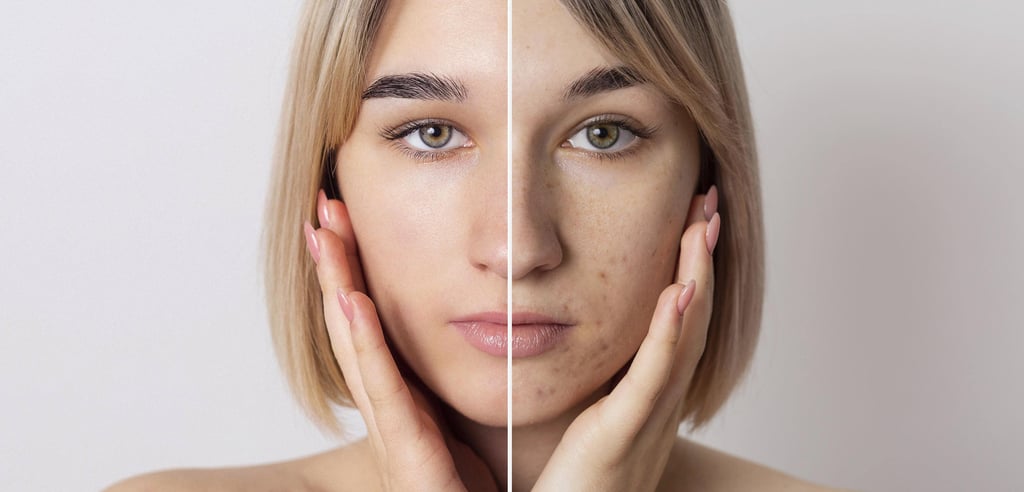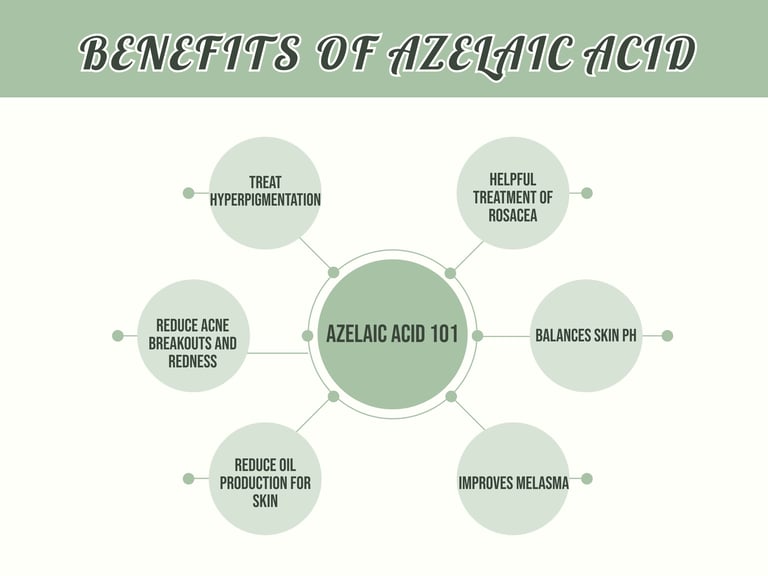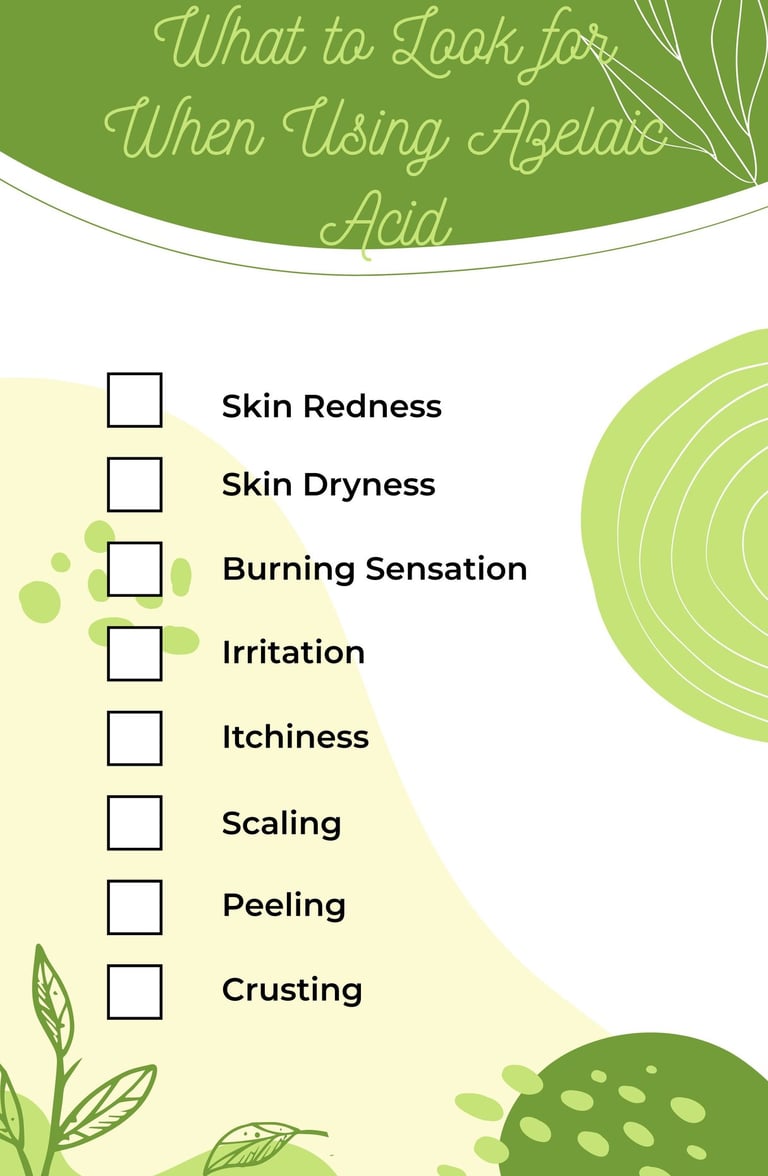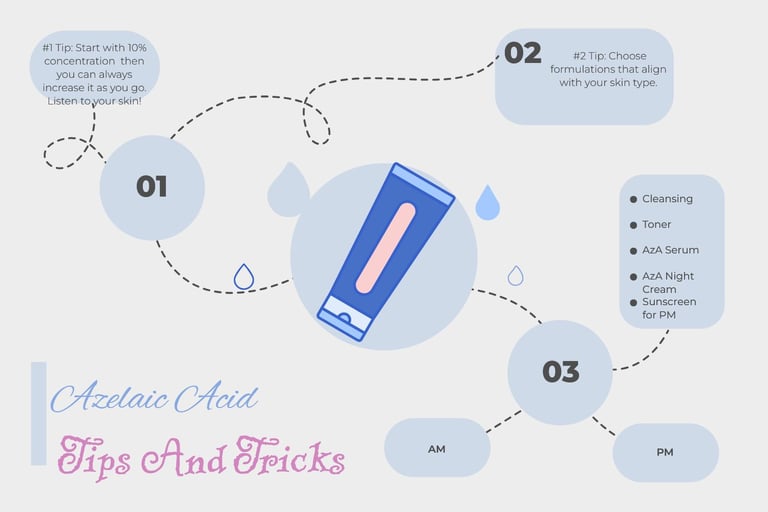Azelaic Acid 101: Why Is It So Underrated?
SKINCARE INGREDIENTS


Introduction
If you’re a skincare enthusiast or you’re always in skincare spaces online then you’ve probably come across the name of this skincare active. Though niche ingredient slowly is making its name be known in skincare industry and unsung hero for anyone with skincare condition that might make going all in for vitamin C or retinol very daunting.
It has been here for quite sometime though not as mainstream. If you have skin condition or fall in acne-prone or sensitive skin then you might have heard that azelaic acid is gentler than other skincare ingredients despite being called ‘acid’.
Naturally, azelaic acid can be found in lots of grains like barley, rye and wheat. But also azelaic acid can be produced by skin’s yeast known as Pityrosporum ovale, its scientific name.
Where Does Azelaic Acid Come From?
Since azelaic can be found in rather smaller amounts in these sources, skincare industry and cosmetic chemists came with another solution of manufacturing it in the lab. Through a process called ozonolysis (adding ozone, a type of oxygen) of oleic acid, found in high amounts in plant oils such as in olive oil then we can get azelaic acid.
Azelaic acid is also known as nonanedioic acid, its chemical name.
How Azelaic Acid Works
Before adding any skincare active, it is wise to know how it works so that you can know how to incorporate it to fit your needs, skin type or skin concern in your skincare journey.
Azelaic acid mechanism of action is by inhibiting tyrosinase which is an enzyme that produce pigmentation. It can also affect peptide LL-37. It is a potent anti-oxidant and has anti-microbial properties that can fight acne-causing bacteria and balance skin pH.
Azelaic Acid Benefits for Skin
What Does Azelaic Acid Do to the Skin?
1. Reduce Acne Breakouts
Among the most prevalent skin concern is other than acne, different types of acne such as comedonal acne ranging from mild to moderate. There are many options for treating acne but they may not be right for your skin type. If you have blemish or acne-prone and sensitive skin type then choices of BHAs or vitamin C may be too harsh for your delicate skin.
So, you can use azelaic acid to treat acne and reduce chances of acne breakouts. From 15% to 20% azelaic acid-containing cream can be very beneficial.
Several studies have proven that azelaic acid can be used to treat acne with satisfactory results for the patients involved.
2. Improves Melasma
Melasma can be stubborn to deal with especially for women who are highly affected by hormonal changes due to pregnancy, breastfeeding or using birth control pills. Melasma can make your skin form dark patches creating uneven skin tone. Again, azelaic acid can reduce melasma appearance on the skin.
One study showed that 20% azelaic acid-containing cream was far better than 4% hydroquinone in treatment of melasma which can be a good choice for darker skin or sensitive skin individuals because hydroquinone won’t be right for them.
3. Reduce Oil Production in the Skin
Azelaic acid is good at removing oiliness. If you have oily skin then dealing with shininess and sweaty look can attract bacteria that feed on the oil this can later cause formation of acne vulgaris that can be hard to deal with.
There are studies that show long-term effect on sebum production after using 20% azelaic acid peel could significantly improve your skin.
4. Helpful Treatment for Rosacea
Rosacea can cause your skin to flush due to enlarged blood vessels under the skin. Other skincare ingredients may lead to inflammation to the skin due to this skincare condition. It is always wise to find an active ingredient that won’t worsen rosacea. One of those ingredients is azelaic acid.
A study found out that azelaic acid of 15 to 20% concentration was effective and better option for treating rosacea.
5. Balances Skin pH
If your skin is slightly acid or alkaline then it can create an environment that can is more prone to harmful bacteria or discourage healthy microbiome to grow on the skin. So using azelaic acid can bring skin pH into balance and foster healthy microbiome to grow on the skin.
6. Treats Hyperpigmentation
Azelaic acid is one of active ingredients that can be incorporated in skincare regimen to reduce hyperpigmentation. Hyperpigmentation is increase in melanin in some patches of the skin which can create uneven complexion. It can be caused by exposure to UVA and UVB sun rays, acne scars or skin disorders.
A clinical study revealed that azelaic acid 15% gel formulation was effective in managing the PIE (Post-Inflammatory Erythema) and PIH (Post-Inflammatory Hyperpigmentation) in subjects. These skin conditions are usually tricky to navigate from in skincare.
Can Azelaic Acid Prevent Stretch Marks?
Azelaic Acid can be a good start in reducing stretch marks but there’s absolutely no guarantee that it can prevent appearance of stretch marks. You have to know that stretch marks is caused by many things including weight loss, hormonal changes among others and cannot be quickly fixed by azelaic acid entirely.
If you have stretch marks, using azelaic acid may reduce the lines partially but skincare procedures may be more helpful.
7. Reduces Skin Redness
Another common skin concern is redness that can be cause by inflammation due to UV exposure from the sun, certain skin conditions or side effects of other skincare ingredients such as retinol, vitamin C, TCA or AHAs which are harsh and can cause redness to delicate or compromised skin barrier.
8. Improve Eczema Symptoms
Eczema skin condition can leave your skin being prone to extreme dryness, irritation and itchiness. With this skin condition, you can find yourself ‘walking on eggshells’ when trying to select ingredients to include in your skincare routine.
One of the ingredients that you should consider adding in your regimen is azelaic acid, which can reduce the itchiness and any kind of inflammation.
9. Treats Perioral Dermatitis
If you find yourself having flaky, redness, peeling and dry skin around your mouth and chin area then consider using azelaic acid to treat this condition. It can reduce inflammation around your mouth and treat acne around the chin area.


What are the Risks of Using Azelaic Acid?
Despite azelaic acid being beneficial in many ways, it comes with its own downsides, a major one being allergic reaction which can manifest as
Skin dryness,
Skin redness
Peeling
Irritation
Itchiness
Crusting
Burning sensation
A dermatologist, Dr. Sam Bunting shares their insights on azelaic acid, “…now one thing that’s worth noting is that azelaic acid can cause some stinging at the very beginning now this is completely normal and happens in almost everyone but it can be alarming for those with sensitive skin…what you’ll find out is that with persistent use that will become much less..”
Who Should Avoid Using Azelaic Acid?
For anyone who is highly prone to skin allergic reactions then you should take precaution when using azelaic acid.
Here’s how to conduct a patch test for azelaic acid:
1. Apply your azelaic acid of, for instance 15% to 20% concentration in gel or cream formulation, on your hand or a place you’re less likely to wash may be your inner arm skin.
2. Leave it for 24 to 48 hours and notice any kind of reactions if its redness, dryness, burning sensation or itchiness on the area of application.
3. If you don’t experience any reactions then you’re good to go. If you notice side effects, stop use immediately. For individuals with skin conditions, consult with a dermatologist before using azelaic acid-containing products.
But also kids below 12 years of age should not use azelaic acid since currently there’s no studies done on children to determine whether the ingredient is goo or bad for younger skin. If the doctor chooses to prescribe it then you can go ahead and use it.
Is Azelaic Acid Pregnant Safe?
Yeah, azelaic acid is considered safe to be used during pregnancy, so if you’re pregnant this ingredient can still be used. Though if you have any allergic reactions or inflammation as stated before then azelaic acid may not be an ingredient you’d want to include in your skincare regimen.
Does Azelaic Acid Interact with Anything?
In matter of fact, azelaic acid is generally safe and gentle skincare ingredient though there are some of the drugs that it can interact with
Isotretinoin
Topical clascoterone


What Does Azelaic Acid Pair Well With?
When it comes to skincare regimen that you’ll be consistent with and get optimal results, it is always wise to find ingredients that can be well paired and work together cohesively without experiencing adverse effects. Here you’ll learn ingredients that can be mixed together with azelaic acid.
Azelaic Acid and Tretinoin
These two can act as powerhouse for dealing with acne and hyperpigmentation. Azelaic acid is anti-bacterial which can be a good choice in killing acne-causing bacteria. Meanwhile tretinoin can reduce hyperpigmentation and fade out acne scars. On the other hand, azelaic acid can counteract the side effects that comes with using tretinoin like redness, irritation or burning sensation.
Is Azelaic Acid More Effective than Retinal?
Since, we’re still in vitamin A section let’s talk about retinol too. These ingredients’ efficacy depends on the skin conditions that you are going to tackle. Azelaic acid will be more effective in dealing with acne breakouts while retinol is more suited for reducing hyperpigmentation.
These two active ingredients are more effective when used together. Azelaic can be used to counter side effects that come with using retinol. If you have sensitive skin you can substitute retinol for azelaic acid but you’ll take more time to see results with it.
Azelaic Acid and Niacinamide
Can I Pair Azelaic Acid with Niacinamide?
In this case both niacinamide and azelaic acid are gentle ingredients. This combination can be used for those with oily skin for effective results. Azelaic acid can be used to treat acne whereas niacinamide may be used for skin brightening of acne scars and spots left behind by PIE or PIH.
One skin expert, Dr. Lindsey Zubritsky said, “…it is one of the most effective ingredients at treating hyperpigmentation because it inhibits an enzyme called tyrosinase that produces melanin in your skin, it works for dark spots, PIH, melasma…works to improve red marks on the skin also known as post-inflammatory erythema, these can be really tricky to get rid off…”
Try using niacinamide serum followed by azelaic acid acne cream can be a skincare game changer.
Azelaic Acid and Vitamin C
These two, azelaic acid and vitamin C can be mixed together and lead to produce great results. Vitamin C can brighten the skin, encourage collagen production and reduce hyperpigmentation. Azelaic acid can reduce acne breakouts but also reduce side effects that come with using vitamin C like dryness, redness, itchiness or inflammation.
Azelaic Acid and Hyaluronic Acid
Another combo that can do well and including it in your skincare routine can be a best decision you’ll ever made in your skincare journey. You can use hyaluronic acid together with azelaic acid, don’t worry with the ‘acid’ word, these two aren’t exfoliating and can be used together without experiencing any side effects.
Can You Use Azelaic Acid Everyday?
Yes, azelaic acid can be used everyday and you should actually incorporate it in your skincare routine especially for blemish, acne-prone or oily skin types. Unlikely AHAs, BHAs and TXA and other astringents that should be used less in a weekly routine.
How Long Does It Take to See Results of Azelaic Acid?
It can depend on concentration and severity of skin issue tackled. If you’re dealing with mild skin issue then within 4 weeks you’ll see positive results. If you have more skin issues then up to 12 weeks to see more optimal results.
Immediate results include reducing skin sensitivity, redness or itchiness on the skin.
What Should not be Used With Azelaic Acid?
Despite azelaic acid being gentle, there are certain skincare active ingredients that we should be careful with when using them with azelaic acid. It should be noted that they can be used together with moderation, taking account on concentration, skin type, skin conditions, the step in the routine and time of the day you can apply them. Let’s explore!
Azelaic Acid and AHAs
First of all, you have to know that AHAs are not something that should be used everyday so if you use AHAs let’s say, glycolic acid then you can alternate it with azelaic acid in days you don’t use glycolic acid to counteract side effects of AHAs.
If you have sensitive skin or skin conditions like psoriasis or rosacea, it’ll be a good idea to stay away from this combination.
Azelaic Acid and BHAs (Salicylic Acid)
When we talk about BHAs most of the time its just no other than salicylic acid. So, these combo can be used together for those who do not have skin conditions or high skin sensitivity.
Apparently, you can use these ingredients together but not combine then in one particular step. You can use salicylic acid in cleansing step then use azelaic acid in moisturizer step. This combo can work well for those with oily skin or combination skin. First, BHAs unclog pores and remove excess oils while azelaic acid reduce acne breakouts and fade out scars from blackheads.
Azelaic Acid and TCA
TCA or trichloroacetic acid is very strong acid in skincare and is always advised to be used with a professional help. Whenever you’ve had TCA peels it is always good to give your skin a rest on the first days.
You can later apply azelaic acid gel or cream to reduce inflammation, redness and peeling to fasten healing process.
How to Use Azelaic Acid In Your Skincare Routine
There are many ways you could use azelaic acid to fit in your skincare regimen according to your needs. Azelaic acid can be added for many benefits that we’ve already outlined above.
1. Cleansing
As a crucial part of any serious skincare routine, cleansing your skin from grime, dirt from pollution, makeup and former skincare routine products. Use oil-based cleanser followed by water-based cleanser to cleanse your face for squeaky clean look and feel. This is called double cleansing.
2. Toner
Apply your toner with toner pads on the clean skin to prepare your skin for further skincare steps. Look for niacinamide toner for those with acne-prone or blemish prone skin. If you have oily skin then you can use salicylic acid to clear pores. Use lactic acid or glycolic acid to prep skin for vitamin C for those with normal skin.
3. Serum
After preparing your face with toner, apply serum that is calming and soothing the skin. At this stage you can use azelaic acid serum or a serum that has it with other skincare actives such as panthenol, vitamin E oil, niacinamide or other bio-actives (liqorice root, green tea extract etc). Azelaic acid can work with other skincare ingredients in simultaneously manner to bring even more optimal results.
Do I Need to Moisturize After Azelaic Acid?
First of all, azelaic acid isn’t drying to the skin, in fact it can cause the skin to be more hydrated. Moisturizing your skin after azelaic acid mostly depends on the step you’re in, in your skincare routine rather than azelaic itself.
Let’s say azelaic acid is in your serum then you’ll need to apply moisturizer after you do serum. On another scenario, azelaic acid is in your night cream and one step before cream is azelaic acid, so as you can notice azelaic acid comes after moisturizer. So, to clarify your statement, moisturizing will likely depend on formulations more often and the skincare steps.
4. Moisturizer
You can layer a creamy moisturizer containing hyaluronic acid, vitamin B5, glycerin, urea or ceramides to seal the azelaic acid serum and let it seep through pores and deep into the skin and tackle the skin issues that you have been struggling with.
5. Sun Protection
In order to preserve the positive results you’ll be getting from azelaic acid then you have to apply sunscreen. There are many sunscreens out there, from mineral to chemical sunscreens but mineral sunscreens that contain titanium dioxide or zinc oxide are more better at offering sun protection. If you don’t want a white cast, opt for tinted sunscreens that can’t leave a white cast on your skin.
6. Night Cream (PM Routine)
If you want to benefit more from azelaic acid then you can also include it in your night cream step. Find a cream that has azelaic acid that has 13% to 20% concentration. After other steps just lathe your face with this cream for evening routine in place of sunscreen, you’ll notice optimal results in 4 weeks even earlier.
What Skincare Products with Azelaic Acid would You Recommend?
Probably the market has to offer a lot when it comes to skincare products but here are the things to look for, percentage and formulation can really affect the overall outcomes when it comes to azelaic acid.
Here look at what Dr. Somji suggests, “…sometimes, when I’ve started patients at 20 at higher formulations, it can be a little bit too much for the skin and it can actually irritate the skin a little bit further…” He then proposes this tip, “…put it in the fridge and when you put it on the skin it’ll be a lot cooler and you won’t get so much of a sting…”
Start with a lower concentration of 10% then you can walk your way to 13% or 15% and beyond, just listen to your skin.
Now look at Azelaic Acid Containing Recommended Skincare products:


The Bottom Line
Azelaic Acid is yet another overtly underrated active ingredient that you should start to pay attention but you have to keep in mind that different skin types may see different results but nonetheless it worth giving it a shot.
References
Alison M. Layton, et al. (2023). Real-World Case Studies Showing the Effective Use of Azelaic Acid in the Treatment, and During the Maintenance Phase, of Adult Female Acne Patients https://pmc.ncbi.nlm.nih.gov/articles/PMC9975535/
Huidi Shucheng, et al. (2024). Effects of 15% Azelaic Acid Gel in the Management of Post-Inflammatory Erythema and Post-Inflammatory Hyperpigmentation in Acne Vulgaris. https://pubmed.ncbi.nlm.nih.gov/38734843/
RH Liu, et al. (2006). Azelaic acid in the treatment of papulopustular rosacea: a systematic review of randomized controlled trials. https://www.ncbi.nlm.nih.gov/books/NBK72976/
Anna Szymanska, et al. (2022). Long-term effect of azelaic acid peel on sebum production in acne. https://pubmed.ncbi.nlm.nih.gov/34731527/
Susan Farshi, et al. (2011). Comparative study of therapeutic effects of 20% azelaic acid and hydroquinone 4% cream in the treatment of melasma. https://pubmed.ncbi.nlm.nih.gov/22151936/
